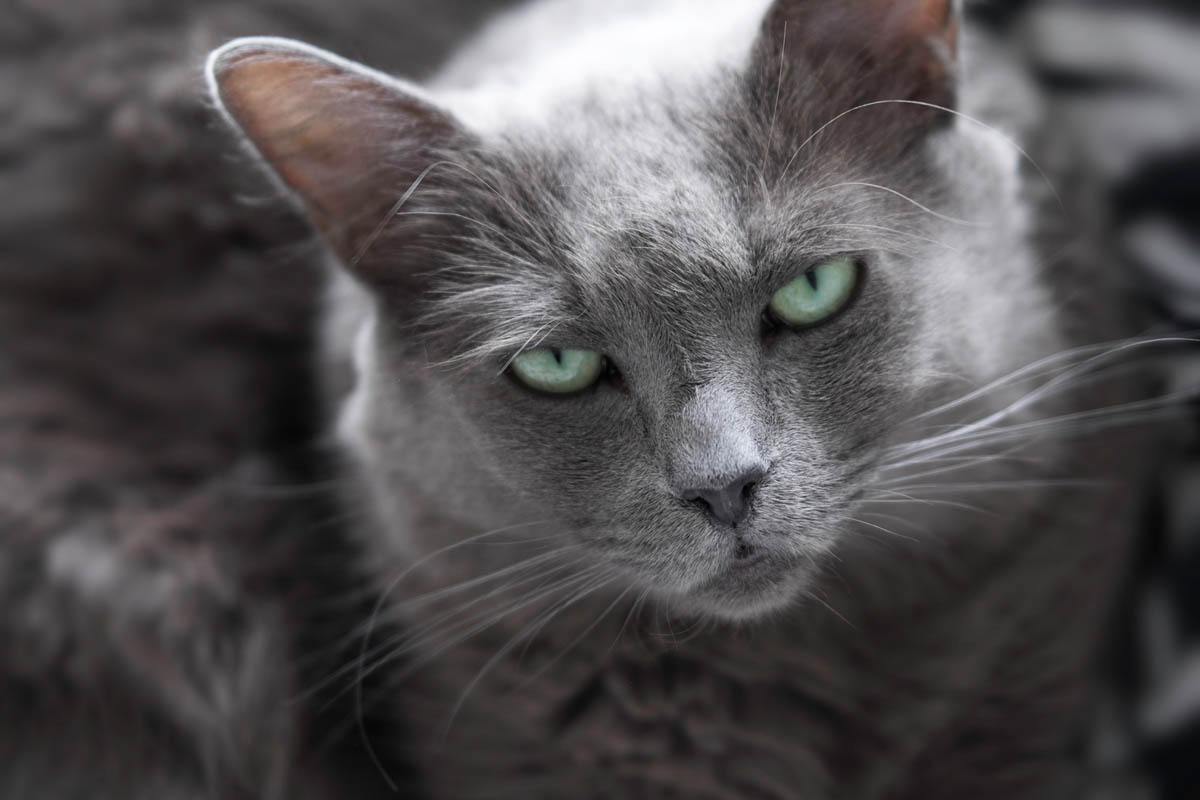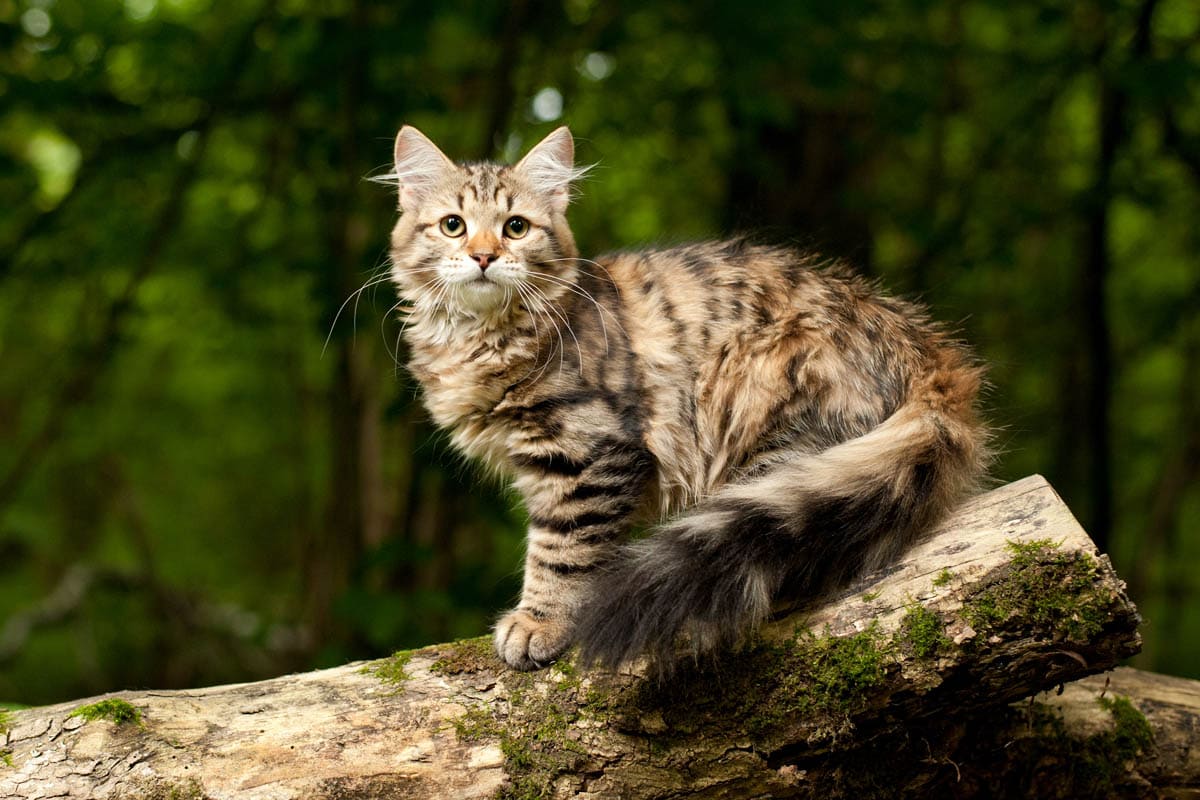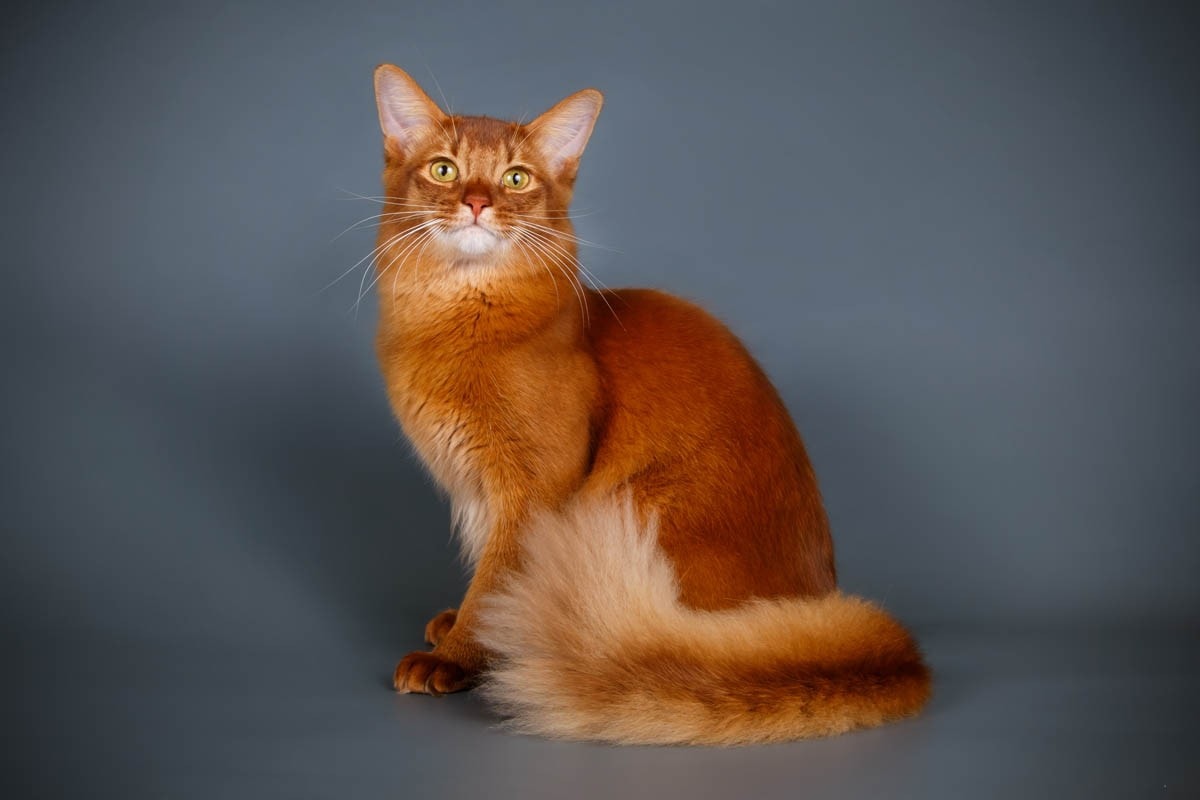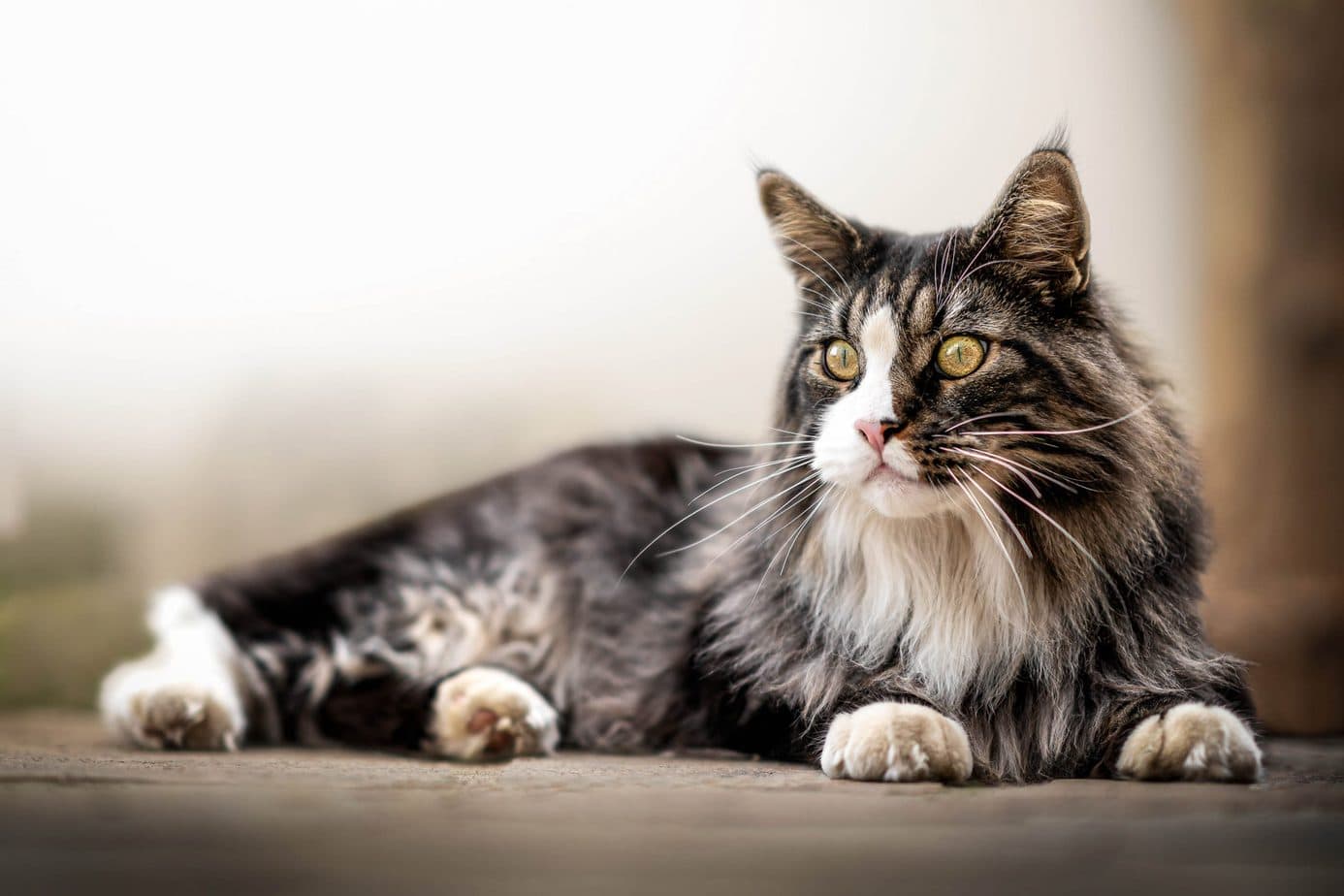Longhaired cat breeds at a glance
- Balinese
- Birman and Javanese
- British Longhair
- Cashmere (longhaired Bengal)
- Longhaired Burmilla
- Maine Coon
- Nebelung
- Norwegian Forest Cat
- Persian
- Ragamuffin
- Ragdoll
- Siberian
- Somali
- Turkish Angora
Balinese and Javanese

- Energy: Moderate
- Cost: $1,000-1,500
- Colours: Seal, chocolate, blue and lilac
- Eyes: Blue
- Lifespan: 12-18 years
The Balinese and Javanese are essentially longhaired Siamese which originated in the United States in the 1950s. Balinese represent the four traditional Siamese colours of seal, chocolate blue and lilac and Javanese all other colours, such as cream, red, lynx and tortie.
Longhaired cats would appear occasionally in litters of Siamese cats, which were sold as pets. Marion Dorsey of Rai-Mar Cattery in California created a breeding plan for these longhaired Siamese followed by Helen Smith of MerryMews Cattery who came on board in the 1950s.
Personality:
Balinese cats are similar to the Siamese in personality, and are outgoing, friendly, intelligent and can be vocal, but less than the Siamese.
Health:
Known health problems in the Birman include:
- Strabismus (crossed eyes)
- Gangliosidosis 1 and 2
- Progressive retinal atrophy
- Mucopolysaccharidosis
- Niemann-Pick disease
Birman

- Energy: Low to moderate
- Cost: $900 – 1200
- Colours: Seal, blue, lilac, chocolate, red, cream, and tortie
- Eyes: Blue
- Lifespan: 12-18 years
The Birman is an ancient breed of cat who as the name would suggest, originated in Burma. Their exact history isn’t known, but they were considered sacred companions of the Kittah priests. Desmond Morris speculated that it is possible local longhaired white cats mated with Siamese cats.
Birmans arrived in France in 1919 with Sita, a pregnant female. One kitten was named Poupee de Madalpour (Poupee), who as bred to Siamese or Siamese type cats (Laotian Lynx) and is considered the founder of the modern-day Birman breed. The French Feline Federation recognised the breed (called Sacre de Birmanie) in 1925.
Personality:
Birmans are a loving and affectionate breed that form close bonds with their human family. They tend to be more laid back than other breeds and not as in your face. The Birman has a sweet and soft voice if he or she talks at all.
Words used to describe the Birman include gentle, amenable, affectionate and loyal.
Health:
Known health problems in the Birman include:
- Hip dysplasia
- Hypertrophic cardiomyopathy
- Hairballs
- Myelodysplasia
British longhair

- Energy: Low to moderate
- Cost: $1,000 plus
- Colours: All coat colours accepted
- Eyes: All eye colours accepted
- Lifespan: 12-14 years
As the name suggests, the British longhair is a longhaired version of the more well known British shorthair. Longhaired cats would occasionally crop up in a litter of British Shorthairs, due to the introduction of Persians after WWI and WWII to save the breed from extinction. The longhaired offspring would be sold as pets but eventually became a breed in its own right.
Personality:
The British Longhair has a similar laid-back personality as its shorthaired cousin. They are calm, even-tempered, easygoing and quiet. British Longhairs tend to not be as demanding as other breeds of cat.
Health:
Known health problems in the British Longhair include:
- Polycystic kidney disease
- Autoimmune Lymphoproliferative Syndrome
Longhaired Burmilla
- Energy: Moderate
- Cost: $1,000 plus
- Colours: Blue, black, chocolate and lilac
- Eyes: All eye colours accepted
- Lifespan: 12-14 years
The Burmilla breed came about as a result of an accidental mating between a lilac Burmese and a silver Persian which produced a litter of four shorthaired kittens with black ticked fur. Longhaired kittens would occasionally pop up in Burmilla litters which were sold as pets until the 1990’s when it was decided to establish these longhaired cats as a breed in their own right.
Personality:
Longhaired Burmillas have a temperament somewhere between that of the Persian and Burmilla. They are laid back, quiet, gentle and placid, but they do have a playful streak too.
Health:
There is not much information on known health problems in the Burmilla, but it is likely they can inherit the same diseases as the Persian and Burmese, which include the following:
- Polycystic kidney disease
- Burmese hypokalemia
Maine Coon

- Energy: Moderate
- Cost: $1,000 plus
- Colours: Solid, tabby, bi-colour and shaded
- Eyes: All eye colours
- Lifespan: 12-14 years
The Maine Coon has been around for centuries and there are many theories as to their origins. The most likely are that they are descendants of local house cats who became semi-wild and adapted to the cold forests by gradually developing a heavy coat.
The breed was first exhibited at Skowhegan Fair, held by New England farmers in the 1860s and twelve Maine Coons were on show at the Boston Cat Show in 1878.
Male cats can weigh more than 8kg, which makes the Maine Coon the largest breed in the cat fancy.
Personality:
Affectionately known as a gentle giant, the Maine Coon is intelligent, loyal, and can bond with one person in the family. Maine Coons love to climb and be up high, so a sturdy cat tree is a must. They also love to play with water.
The Maine Coon loves human companionship and will follow you around the house and be a part of what you are doing. Some can be talkative, their voice is more a high-pitched trill than a meow and can be used in various tones depending on how they want to talk to us.
Health:
Known health problems in the Maine Coon include:
- Pyruvate kinase deficiency
- Spinal muscular atrophy
- Hypertrophic cardiomyopathy
Nebelung

- Energy: Moderate
- Cost: $1,000 plus
- Colours: Grey
- Eyes: Green or yellow/green
- Lifespan: 12-14 years
The Nebelung is a rare breed of cat that has the appearance of a longhaired Russian Blue. Elsa, a black domestic shorthair cat produced a litter of six kittens sired by a grey longhaired sire. One male, named Siegfried had a semi-long coat. Five months later Elsa had a litter of seven, with a black longhaired kitten and a grey one named Brunhilde. Siegfried and Brunhilde became the foundation cats for the Nebelung breed.
Personality:
Nebelung cats are gentle, quiet and can be shy with strangers but are loyal and loving with their family. Words used to describe the Nebelung include intelligent, playful and active. People often describe their dog-like nature.
Health:
There are no known inherited health conditions in the Nebelung.
Norwegian Forest Cat

- Energy: Active
- Cost: $1,000 – $1500
- Colours:
- Eyes: All eye colours
- Lifespan: 12-15 years
The Norwegian Forest cat is a naturally occurring large, long-haired breed from Norway. Records indicate that longhaired cats have been present in Norway for hundreds of years. It is believed that longhaired cats are descendants of cats brought to Norway by the Vikings via trade routes, with Siberians and Turkish Angoras considered to be founding breeds of the Norwegian Forest cat.
Personality:
The Norwegian Forest cat is an easy-going and mild-mannered cat. Unline many longhaired breeds, the NFC is active and is known for its excellent climbing ability. They love to be up high, so it is important to provide them with a high cat tree or perch.
They are incredibly intelligent, make ideal family pets and get along well with children. They are extremely affectionate, like nothing more than being stroked and given attention.
Health:
Known health problems in the Norwegian Forest cat include:
Persian

- Energy: Low
- Cost: $850 – $1,200
- Colours: All coat colours and patterns
- Eyes: All eye colours
- Lifespan: 11-14 years
One of the oldest cat breeds, the Persian is a long-haired breed characterised by its round face and short muzzle. The breed originated in Persia (Iran) and became a popular breed on the show benches in 1800s Europe.
Chinchilla cats are a separate group who are classed as Persian in some cat councils, they have a ticked coat. Himalayan cats are pointed Persian cats.
Personality:
The Persian is a quiet, laid back and gentle breed of cat. They like to spend time with their human family and have a playful side, but are not overly demanding and don’t get into trouble as more active breeds can.
Health:
Known health problems in the Persian include.
- Persian cats are brachycephalic, which means they have a short, flat face, this can lead to problems such as excessive tearing of the eyes, dental problems, eye ulcers and breathing difficulties
- Polycystic kidney disease
- Progressive retinal atrophy
- Alpha-mannosidosis
Ragamuffin

- Energy: Medium
- Cost: $1,000-$1,200
- Colours: All coat colours and patterns
- Eyes: All eye colours
- Lifespan: 10-14 years
The Ragamuffin is a variant of the Ragdoll cat which came about when Ragdoll breeders split from the International Ragdoll Cat Association, run by Ann Baker, the Ragdoll cat founder. As Ann had trademarked the name Ragdoll, breeders chose RagaMuffin.
RagaMuffins come in a variety of non-pointed colours as well as colour pointed (although the Cat Fanciers Association don’t accept colour pointed RagaMuffins).
Personality:
RagaMuffins are sweet, intelligent, affectionate and people-oriented. Like their Ragdoll cousins, they often go floppy when picked up.
RagaMuffins are slow to mature and retain their kitten-like playfulness well into adulthood.
Health:
Known health problems in the RagaMuffin include:
- Hypertrophic cardiomyopathy
- Polycystic kidney disease
Ragdoll

- Energy: Medium
- Cost: $1,000-$1,200
- Colours: Seal, chocolate, blue, lilac, red (flame)
- Eyes: Blue
- Lifespan: 10-14 years
The Ragdoll is one of the largest domestic cat breeds, with stunning blue eyes and a semi-longhair coat. A Persian/Angora type cat called Josephine was hit by a car and was taken to the veterinary hospital at the University of California by Ann Baker. Ann claimed Josephine was subjected to government testing, which lead to her becoming limp like a ragdoll when picked up. Josephine had two sons to two fathers who had the same laid-back temperament as Josephine. Blacky, a black cat and Raggedy Ann Daddy Warbucks who was cream, with dark points and white mitts. These boys were to become the founding fathers of the Ragdoll breed.
Personality:
Ragdolls are said to be one of the most docile of cat breeds. They are mild-mannered, relaxed, and loving. In his book Cat Breeds of the World, Desmond Morris writes that Ann Baker did not consider the British Ragdolls to be true Ragdolls because they were not sufficiently floppy.
Ragdolls are easy to train and many enjoy a game of fetch. They will greet you at the door and follow you around the house, and love to curl up on the sofa with their human family.
Health:
Known health problems in the Ragdoll include:
- Hypertrophic cardiomyopathy
- Polycystic kidney disease
Siberian

- Energy: Medium
- Cost: $1,200-$1,600
- Colours: All colours and patterns
- Eyes: All eye colours
- Lifespan: 10-14 years
The Siberian is a large natural breed of domestic cat from the taiga of Siberia. They made an appearance at the first cat show in 1884 in Madison Square Gardens, London.
Siberians are said to be hypoallergenic, while no cat is truly hypoallergenic, the Siberian cat does have a lower than average amount of FelD1 in their saliva, which is the protein that triggers allergies in affected people.
The Neva Masquerade is a pointed variation of the Siberian.
Personality:
The Siberian is an affectionate breed of cat with a dog-like nature. They love to greet visitors at the door with a friendly chirp and will happily follow their humans around the home. It is said that the Siberian cat loves water.
Slow to mature, it can take up to five years for the Siberian to reach maturity.
Health:
There are no known inherited health conditions in the Nebelung.
Somali

- Energy: Medium to high
- Cost: $900-$1,400
- Colours: Ruddy, red, blue, and fawn
- Eyes: Green and gold
- Lifespan: 12-16 years
The Somali is a longhaired Abyssinian and shares a similar story to other longhaired breeds who share a history with shorthaired breeds. From time to time a longhaired kitten would pop up in a litter of Abyssinian kittens and would be sold as a pet. One such longhaired kitten named George was given away. Sometime later, he was surrendered to an Abyssinian breeder who felt it unfair that these beautiful longhaired kittens were dismissed and decided to develop them as a breed with much resistance from Abyssinian kittens at the time.
Personality:
The Somali has a similar personality to the Abyssinian, they are active, intelligent, extroverted, gregarious, inquisitive and on the go. Somali cats love to climb and be up high.
As an intelligent breed, the Somali is easy to train.
Health:
Known health problems in the Somali include:
- Progressive retinal atrophy
- Pyruvate kinase deficiency
Turkish Angora

- Energy: Medium to high
- Cost: $1,200-$1,500
- Colours: All coat colours, but white is the most common
- Eyes: All eye colours
- Lifespan: 10-15 years
One of the oldest naturally occurring breeds, the Turkish Angora gets its name from the capital of Turkey, Ankara, which was previously called Angora.
The earliest mention of the breed dates back to the 1600s, and later Harrison Weir talks about them in his book Our Cats and All About Them, dated 1889 where he writes:
“They are not new to us, being mentioned by writers nearly a hundred years ago, if not more. I well remember white specimens of uncommon size on sale in Leadenhall Market, more than forty years since; the price usually was five guineas, though some of the rare excellence would realise double that sum”.
The breed almost vanished in the early 20th century due to greater interest in the Persian cat. Ankara zoo established a breeding programme to preserve the national treasure, with a focus on breeding white cats with odd eyes. American servicemen re-discovered the breed and in 1962, Colonel and Mrs Walter Grant imported the first pair of Turkish Angoras to the United States.
Personality:
The Turkish Angora is curious, sociable, gentle and energetic. They thrive on human company and will often form a strong bond with one particular member of the family.
As the Turkish Angora is intelligent, they are easy to train to walk on a leash or play fetch to help burn off some energy.
Health:
The Turkish Angora is a healthy breed, however, blue-eyed cats with a white coat may be deaf.

